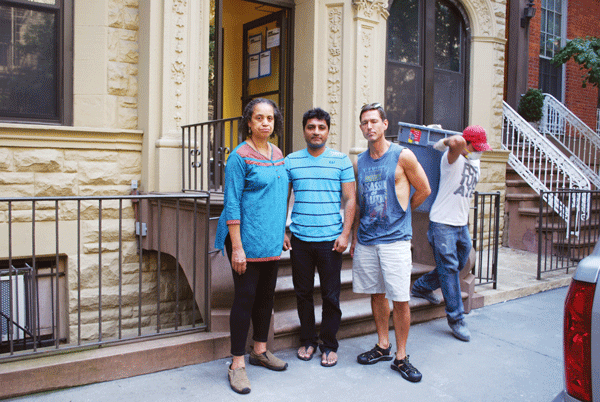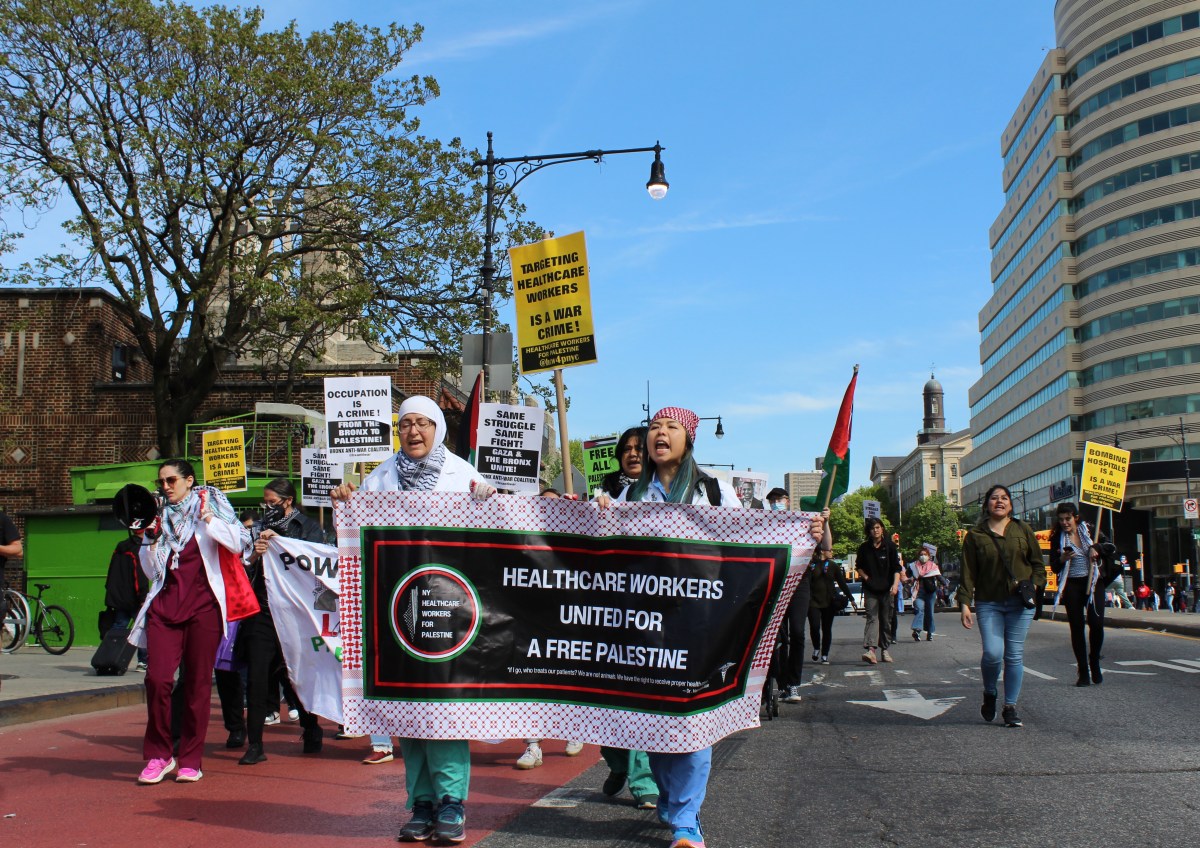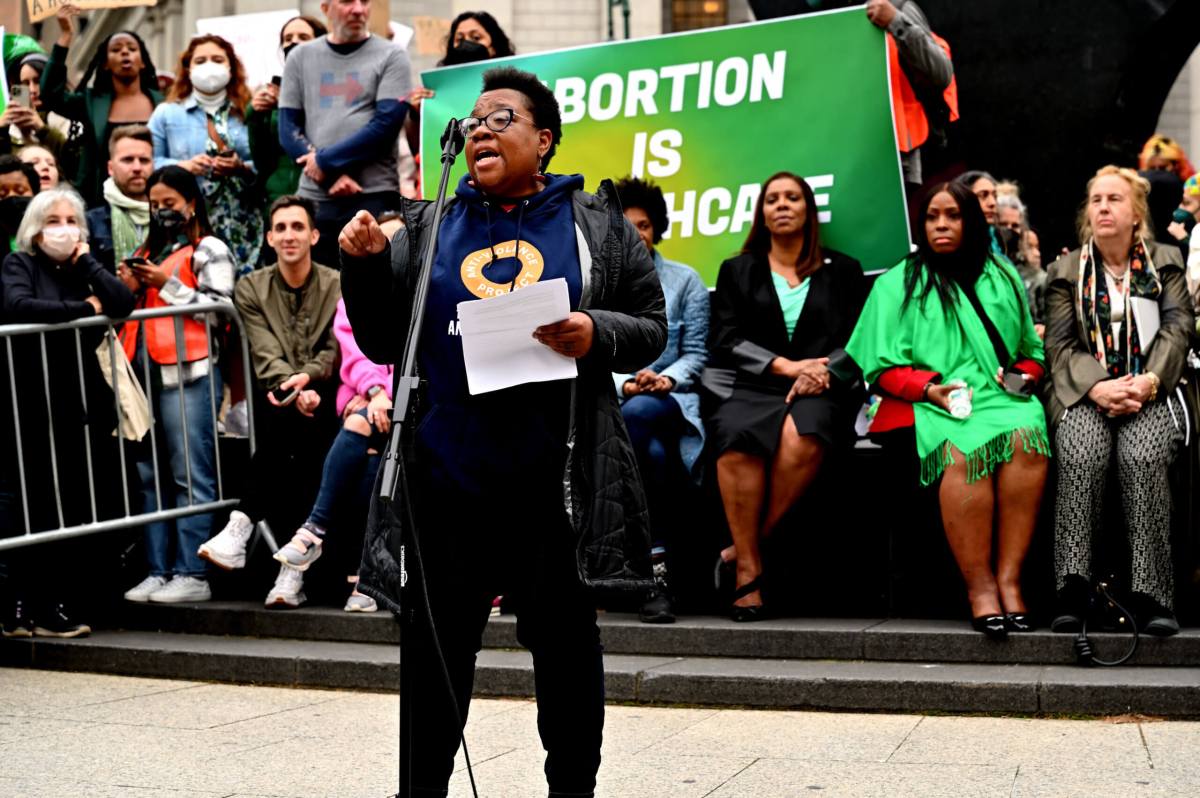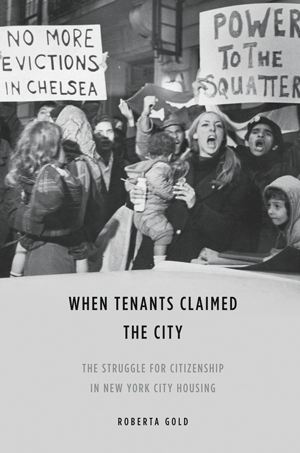
History repeating itself: Chelsea tenants from another era are cover material for this book by Roberta Gold, who teaches American Studies at Fordham University and has been an active member of her Tenants’ Association in Harlem for two decades.
BY WINNIE McCROY | In a case of landlord harassment that State Senator Brad Hoylman called “egregious,” the longtime tenants of 222-224 W. 21st St. are allegedly being illegally evicted so that Slate Property Group can construct high-end rentals in place of their subsidized housing.
Only seven of the original 23 tenants remain, and these holdouts say they are subjected to drilling and jackhammering from 7 a.m. until midnight, random cuts to utilities (including water, cable and Internet), unsafe living conditions, and a campaign of harassment intended to make them leave their home of nearly 20 years.
By the time tenants Cher Elyse Carden, Andrew Rai and Steve Schaeffer contacted Chelsea Now about what was happening to their home, construction workers had already torn out the floors and ceilings, walls and insulation, locked them out of the basement storage and laundry room, disconnected their buzzers and changed the locks on their front door.
“If I had the money, I would have packed up and moved,” said Carden, who has lived in the building since 1986. “Now I’m appalled that this seems to be endemic in the city. If they would have kept 20 or 30 percent of it as affordable housing, that would have been okay. But they didn’t. They just bulldozed their way through.”
All seemed fine in the building until it was sold this March. By the end of the month, tenants came home to discover a generic eviction notice from MGT Property Management, which informed them that they would “be required to vacate and surrender the premises on or before April 30, 2014.”
“You could hear people crying in their apartments after this happened,” Carden recalled. “The superintendent was doubly sad, because he had lost both his home and his job.”
Later, the remaining tenants received a more formal-looking notice from the landlord’s attorneys, Belkin Burden Wenig & Goldman, LLP — requiring them to terminate their tenancy by Aug. 31, 2014 (the “Vacate Date”) or face “summary proceedings under the Statute to remove you from the apartment for the holding over after the expiration of your term.”
“A lot of tenants got these generic eviction letters, where the lawyer writes a scare tactic letter saying in 30 days we will start eviction proceedings,” said Carden. “But it’s not legal until they actually take you to Housing Court and have a hearing, and the court then sends you a letter. We would be a ‘holdover,’ meaning the landlord thinks a tenant is staying beyond their lease time.”
Some of the residents, who were not U.S. citizens or didn’t have official leases (rentals have operated on a month-to-month basis since the economic bust of 2008) reportedly got scared and left soon after. At the end of April, a young woman with brain cancer left to go live with her mother, said Rai. Between May 25 and mid-June, 15 more people left.
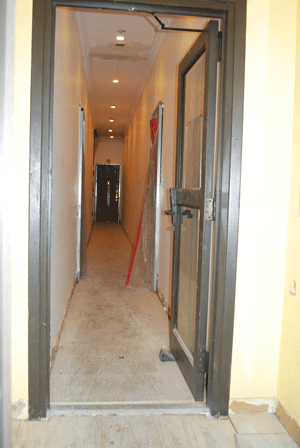
The entryways of 222-224 W. 21st St. are hung with plastic barriers that workers pass through to carry garbage cans full of drywall and other dismantled building parts.
One woman who wanted to stay came home to find the owner and several men in her living room, telling her she had to leave by the end of the weekend. When she balked, said Rai, a “pipe broke” near her closet, ruining all of her clothing. She moved out soon after.
“People got scared,” said Rai, a social worker who has lived in the building since 1998. “Most tenants don’t know what their rights are.” The problem was, the holdouts weren’t exactly sure of their rights, either. So they banded together to figure out exactly what was happening with their home.
“It’s history repeating itself,” said Carden, pointing to the cover of the Roberta Gold book, “When Tenants Claimed the City,” whose cover shot features tenants picketing in front of her very building.
PRESENT CONFLICT HAS DEEP ROOTS
The saga of the building’s current renovations began way back in 1972, when the previous owner (McConnell Wetenhall & Co.) took out an Article 8 loan under the New York City Private Housing Finance Law program to renovate. Under the law, the apartments were placed under rent control for the 20-year duration that the loan was in place, during which the owner received a J-51 tax abatement/exemption. The Division of Housing and Community Renewal (DHCR) indicated that the apartments would be subject to the Rent Stabilization Code immediately after rent decontrol went into effect.
In New York City, rent stabilization applies to buildings with six or more units. It gives tenants the right to renew their leases, and protects them from sharp rent increases by having the Rent Guidelines Board set the allowable percentage increase for rent renewals each year.
Rent stabilization came to this building back in April 2004, 20 years after the loan was paid off. But tenants said that they never received any notice that their rent was now stabilized, a requirement under the law.
By October 2005, the owners had petitioned the DHCR to remove rent stabilization altogether, citing the extensive improvements they had made to the building — back in 1972. The court removed the rent stabilization, providing only 180 days for “undue hardship the tenant may face upon the issuance of this order.”
But tenants still didn’t receive any word from owners about these changes, with Rai saying, “Our leases were basic. There was no indication of a J-51 loan or the rent stabilization change. The managing agents of the previous owner lived next door, and later told us that the apartments had once been rent stabilized. That’s when we decided to look further into this. Because how do you destabilize rent that was never legally stabilized?”
Rai said they took the case to a DHCR officer, who found it so confusing, he advised them to hire a lawyer. After trying unsuccessfully to get Legal Aid on the phone, they approached Hoylman, who asked the lawyers at the nonprofit Housing Conservation Coordinators (HHC) to hear them out, even though the building was outside their usual service area.
CITY OFFICIALS STEP IN TO HELP
By the time they got help from elected officials Hoylman, Councilmember Corey Johnson and Assemblymember Richard Gottfried, only seven tenants were left in the building.
Bob Kalin and Betsy Eichel from HHC investigated their situation, and Rai said they offered some hope in their story of a similar case of a building that was destabilized without tenants being informed.
“He said he recently won a case like ours, and that if…tenants weren’t notified of their destabilization, they are automatically rent stabilized,” said Rai. “We want to be reverted back to rent stabilized status. If we knew it was going to be destabilized, we would have fought it. We want to stay here. This is our home.”
“My understanding is that if they argue that the building was improperly destabilized and they win, they would stay in their homes and would fall under the umbrella of rent regulation in some form,” noted Eichel, who stresses that she is not a lawyer, and is primarily helping tenants with concerns like security, noise and unscheduled cuts to utilities. “If they wanted to relocate, they could avoid dealing with Housing Court and negotiate a buyout. I believe some tenants did go this route, but the people I am working with are committed to staying, if at all possible.”
Elected officials have been sending their representatives to Tenants Association meetings, and following up with tenants’ complaints to 311 and the Department of Buildings. This helped when the landlord got a two-week variance to work from 6 p.m.–12 a.m., Monday through Friday, a measure intended for high-traffic areas where construction would otherwise be dangerous. It also helped them obtain a Stop Work order.
“They took down the firewalls that keep a fire from spreading from room to room, and save your life in the case of a fire,” said Rai. “The inspector was horrified that you could see through the bedroom walls, that there was no barrier between floors. He placed a Stop Work order on the building until necessary safety measures were taken. It’s all plywood. It looks terrible.”
In that aspect, it looks pretty much like the rest of the building. The marble entryway was reduced to jagged shards of cement and stayed that way for months until workers were ordered to lay down a plywood floor. The entryways are hung with plastic barriers that workers pass through to carry garbage cans full of drywall and other dismantled parts of the building to the dumpster sitting flush with the curb. In short, it doesn’t look like a place that even a squatter would want to live.
And these “subsidized Section 8” tenants are hardly the welfare cases that some would make them out to be. Curious as to the “low-rent” price tag that these tenants pony up each month to live in this hell house? Upwards of $3,200 a month — hardly “affordable housing” in the eyes of most Americans.
“This is a case of unscrupulous landlord who is literally and figuratively gutting New York’s housings laws by trying to convert the building into market-rate apartments,” said Hoylman. “It’s a tried and true tactic of an unscrupulous landlord who harasses tenants, refuses to inform them of their legal rights, doesn’t issue new leases and then makes their life a living hell through construction. And if you don’t have a lawyer or know the housing law, you probably do what many of these tenants do, which is move out and give up their homes, and that’s wrong. We have laws to protect these tenants and that’s why the Councilmember and Assemblymember and I have gotten them legal representation, and will continue to fight for their rights.”
According to the New York State Attorney General’s Tenants’ Rights Guide (ag.ny.gov), a landlord cannot use “threats of violence, remove a tenant’s possessions, lock the tenant out of the apartment, or willfully discontinue essential services such as water or heat.” The NYC Admin. Code Subsection 26-523 and 26-521 also says that a tenant evicted from an apartment in this unlawful manner is “entitled to recover triple damages in a legal action against the landlord,” who could be subject to “both criminal and civil penalties. Further, the tenant may be entitled to be restored to occupancy.”
But when the case goes to Housing Court, as Johnson says it most likely will, this failure to inform tenants of their rent stabilization status may well be the deciding factor.
“I’m not a lawyer, but the building’s rent stabilized history dates back to 1989, so this has been going on for 25 years and a lot has happened since. A judge needs to look at what’s occurred. The landlord is required to let tenants know if rent has been destabilized, so this calls into question their situation for the past 10 years,” said Johnson.
Hoylman — who is a lawyer — agrees, saying, “That seems to be the case. The lawyers sent a notice ending their tenancy, but many of those tenants were rent stabilized and they can’t do that.” He said that he would work with the tenant’s attorneys at DHCR via their Tenant Protection Unit, which looks at “bad actors like this landlord, and hopefully will intercede and protect their homes.”
The management company for the building is Slate Property Group, a real estate investment firm founded last fall by Martin Nussbaum, a founding principal at Silverstone Property Group, with top executives Steven Figari and Michael Zampetti joining him in the venture, to be operated out of 850 Third Ave.
When Chelsea Now asked Zampetti, Slate Property Group’s Owner Representative for the building, about the current situation at 222-224 W. 21st St., he simply replied, “We have no comment.”
LOCKS CHANGED, SERVICES CUT
Meanwhile, the harassment continues. It started early, when construction workers ripped out the marble entrance hallway, leaving 30 feet of jagged concrete for tenants to tiptoe over. Then there were the sounds of drilling, coming from all directions. Next, there was no hot water, or for some residents, no water at all.
“The people in 222 didn’t have water for three days, and why they didn’t scream bloody murder is beyond me,” said Steve Schaeffer, a tenant since 1992. “There is a hole in my radiator that goes straight through the floor. The only thing separating me from the apartment below is the floorboards.”
Workers reportedly cut the phone and cable lines of a neighbor with two young kids, and got a variance to work on Saturdays starting at 7 a.m.
Then came the stories of damage to personal belongings. Rai and Carden said that the former managing agents, elderly couple Sidney and Sandy Gecker of 226 W. 21st St., had stored their antiques and rare books in the basement, and had made an arrangement with owners to get their things out. After the July 4 weekend, the new landlord reportedly threw all of the Geckers’ antiques into a dumpster. They then changed the basement locks, providing tenants no keys to the room where they stored their bikes. When Rai finally did see the basement door left ajar, he went in to retrieve his bike, only to find the lock broken and his bike stolen.
“I called the police and filed a complaint with the 10th Precinct,” said Rai. “They tried to call the super, who came to my apartment that evening and said ‘Sorry, I don’t know where your bike is.’ But one construction worker told police that he saw the bike the day before.”
Insult was heaped on injury when tenants found the stairwell landing bulbs removed, and the fire lights ripped out. They gritted their teeth when they discovered that the doorbell buzzers had been disconnected, preventing them from buzzing neighbors in.
“Forget about FedEx,” said Carden.
On June 25, tenants came home to find that the landlord had changed the lock on the front door of the building, without providing them with a key. Carden said, “It wasn’t until I angrily spoke to these workers and insisted that we get keys that we were let in.”
“We’d have to wait until a construction worker came out or phone a neighbor to get in,” added Rai.
On June 30, Carden discovered that the door to the laundry room was padlocked with no explanation. Management later attributed this to “safety reasons,” but as she notes, “a service we’ve had for three decades now is gone, and we have to take our clothes to the laundromat, which is three times as expensive.”
Workers did remove some padlocks, however, including those on the roof of the building. This creates a safety issue, as anyone from adjacent buildings can now easily enter 222-224 W. 21st St., where apartments under renovation are reportedly left wide open, some with windows taken out, leaving six-foot holes in the wall that anyone could fall right through, worried Carden.
In late June, they began tearing down the apartment walls and converting one bedrooms into two-bedrooms, and two-bedrooms into three-bedrooms. Able to see clearly between rooms, Carden became alarmed at the fire danger, and called the DOB to inspect this.
In addition to the physical perils, the tenants have also reported feeling psychologically tormented by the new landlord and his agents.
Schaeffer said that since the construction workers tore out the walls, ceilings and insulation, he could hear every conversation workers have. Most disquietingly, he said, are moments like when he recently awoke, sat up in bed, and before his feet even hit the floor, heard workers below say, “He’s up.”
Rai said that he believes the workers monitor their presence, following them from room to room from the apartment to spy on them, and alternately to drill and make loud noises, to harass them into leaving.
“It’s a coordinated plan to annoy us so we’ll leave, but it makes me just want to dig my heels in,” echoed Schaeffer. “At no point did anyone try to talk with us about their plans. They just say get out in 30 days, but if you’ve lived somewhere for 15 years, that’s an unreasonable expectation.”
Although this seems hard to believe, during a recent visit, the loud pounding of construction noises came to a halt during the time this reporter visited the tenants on-site. They resumed when we exited Schaeffer’s apartment, and all of the adjoining apartment doors that had been wide open were now shut tight.
EGREGIOUS CASE NOT AN ISOLATED ONE
It would be comforting to think that this hellish scenario is an isolated incident inflicted on this ragtag group of uninformed tenants on W. 21st St. But in reality, it is a common occurrence.
“The overheated housing market in Chelsea has created an incentive for bad actors like this landlord to try and move tenants out and move market rate tenants in,” said Hoylman. “This is a crisis that I see all across my district, on both the East and West Side. Because many of these tenants are rent regulated and in very valuable properties, landlord will often go to illegal measures to get rid of them, like turning off their hot water or making excessive noise.”
A community activist recently reported a similar situation occurring on W. 22nd St., just one block away, where tenants who should be rent stabilized are being given eviction notices.
Community Board 4 District Manager Bob Benfatto said while they haven’t received many complaints, tenants often approach elected officials or housing advocacy groups in these situations. He did, however, reference a recent situation at a Hell’s Kitchen Catholic Charities property, where the nuns at St. Joseph’s Immigrant Home raised the rent nearly 50 percent on the working class women living there in a bid to boot them out.
“It feels like it’s becoming more common,” said Johnson. “We’ve seen in the past months multiple buildings that have situations like this, but what’s occurring on 21st Street is the most egregious we’ve seen.”
PLEDGES TO STAND WITH TENANTS, STRENGTHEN LAWS
For these seven tenants, living in a building that is literally being torn down around them, what is their end game? Do they want to stay in a building where owners clearly have an animus toward them? Could they be compensated for their troubles with enough money to set up a household someplace else?
“There needs to be notification when there are changes, some communication between management and the tenants,” said Carden. “And we would like to have the restoration of services like laundry, basement access, etc.” Rai added that they also wanted to get their status as rent stabilized tenants back.
Hoylman said that the best-case scenario would be if they got DHCR to step in while they continue to fight back in court so that the landlord stops the disruptive work and the tenants get to stay in their homes. At the least, he said, these people should be treated with the dignity they deserve, rather than the disrespect that’s been heaped upon them.
It is this behavior that Hoylman is trying to make illegal, per Senate Bill 1273, legislation he has sponsored in Albany that would strengthen anti-harassment laws.
Gottfried championed Hoylman’s efforts to eradicate this type of harassment, saying, “What’s happening at 222-224 West 21st Street is a really bad case of landlord greed destroying affordable housing. Unfortunately, it’s been going on for a long time, in lots of buildings. We’re working to help the tenants save their homes. But we also need stronger laws.”
Elected officials agreed that these bastions of affordable housing must be kept because the diversity of housing stock on the West Side is crucial to maintaining the balance of community interests that keep Chelsea, Greenwich Village and Hell’s Kitchen a great place to live.
“So many of our beloved community members live in rent stabilized housing and we need to protect their rights,” said Hoylman. “We need places for people like schoolteachers, artists and government workers to live in our neighborhood. It enriches all of us to have a diverse community. If we’re gentrified to the point where we’re one class of very rich people, that’s a sad day.”
Carden echoed this sentiment, saying, “I got to move from my home of 28 years so someone else can get rich? They call it gentrification. But they get tax abatements for affordable housing.”
At least now, said Rai, the landlord will know that they are organized and fighting, and that they have the elected officials behind them.
“It’s our hope that they can get protection under the Rent Stabilization law and are able to live in a building that is safe and free from harassment,” said Johnson, vowing, “I will stand shoulder to shoulder with these tenants, and help as this moves forward to ensure they are protected.”



